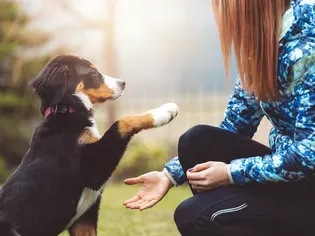10 Tips to Help You Train Your Puppy
Updated on 04/26/24

Unlock Your Pup's Potential: The Ultimate Guide to Puppy Training
Raising a puppy is an exciting journey, but it can also come with its share of challenges. To help you navigate this rewarding experience, we've compiled a comprehensive guide featuring 10 essential tips to transform your adorable pup into a well-behaved companion.
1. Establish a Clear Routine
Consistency is key when training a puppy. Establish a regular schedule for feeding, potty breaks, playtime, and naps. This predictable routine will help your pup learn what to expect and make potty training much easier.
Example: Feed your puppy twice a day at the same times each day, take him outside for potty breaks every 2 hours, and provide ample playtime and rest throughout the day.
2. Use Positive Reinforcement
Reward your puppy every time he exhibits desirable behavior. Treats, praise, and cuddles are all effective rewards that will reinforce good habits.
Example: When your puppy goes potty in the designated area, give him a treat and tell him, "Good potty!"
3. Keep Training Sessions Short and Sweet
Puppies have short attention spans, so keep training sessions brief—around 5-10 minutes. This will ensure that your pup remains focused and doesn't get overwhelmed.
Example: Practice sit-stay for a few minutes every day, breaking it down into small steps: say "sit," reward him, and gradually increase the time he stays sitting.
4. Start with Basic Commands
Don't rush into teaching complex tricks. Start with foundational commands like sit, stay, come, and heel. Once your puppy masters these basics, you can gradually introduce more advanced commands.
Example: Teach your puppy to sit by holding a treat in front of his nose and slowly moving it backward over his head. When his bottom touches the ground, say "sit" and give him the treat.
5. Socialize Your Puppy
Exposing your puppy to different people, animals, and environments will help him become a well-rounded dog. Start by taking him on short walks, attending puppy classes, and introducing him to friends and family.
Example: Take your puppy to the park on a leash and let him interact with other dogs and people in a controlled setting.
6. Be Patient and Consistent
Training a puppy takes time and patience. Don't get discouraged if he doesn't learn everything right away. Consistency is key—stick to your training methods and provide plenty of positive reinforcement.
Example: If your puppy starts jumping on visitors, calmly tell him "no" and guide him to sit. Repeat this process consistently every time he jumps.
7. Enroll in Puppy Classes
Puppy classes are an excellent way to socialize your pup and learn valuable training techniques from experienced professionals.
Example: Look for classes that cover basic obedience, agility, and socialization.
8. Use a Crate for Training
A crate can be a valuable training tool for puppies. It provides a safe and comfortable space where they can learn to be calm and relaxed.
Example: Start by placing your puppy in the crate for short periods with treats and toys. Gradually increase the time spent in the crate until he is comfortable spending time there.
9. Seek Professional Help if Needed
If you encounter any significant problems training your puppy, don't hesitate to seek professional help from a certified dog trainer or veterinarian.
Example: If your puppy is exhibiting aggressive behavior or severe anxiety, consult with a professional for guidance and support.
10. Enjoy the Journey!
Training a puppy is a rewarding experience that will strengthen your bond with your furry friend. Remember to have fun and celebrate your puppy's progress along the way.
Example: Take time to play fetch, go for walks, and cuddle with your puppy. Remember that training should be a positive and enjoyable process for both of you.
By following these 10 tips, you'll be well on your way to raising a well-behaved and happy puppy who will bring joy into your life for years to come. Patience, consistency, and a loving approach are the keys to success. So, embrace the journey and enjoy the incredible bond you build with your furry companion.
Explore More Pets

Basic Training
Puppy and Baby Introductions

Working Dog Breeds
All About Search and Rescue Dogs

Dog Treatments
Puppy Vaginitis: Signs, Causes and Treatment

Dog Adoption
After More Than 1,200 Days in the Shelter, Coco Goes Home

Basic Training
How to Train Your Puppy to Go on Potty Pads

Hybrid Dog Breeds
The Difference Between a Mutt, Mixed Breed, or Designer Dog?

Dog Treatments
Nail Problems in Dogs

Puppies
7 Reasons Why Two Dogs Are Better Than One